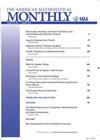幽灵无理数
IF 0.4
4区 数学
Q4 MATHEMATICS
引用次数: 0
摘要
有理数可以用比率表示,而无理数不能。希帕索斯有时被认为发现了一个正方形的对角线长度是一个无理数。这是数学史上的一个重要发现。康托的对角线论证也加深了我们对有理数和无理数的认识。前者是可数无限的,后者是不可数无限的。它们在现实中也有不同的密度。我写了一首诗,描述了理性和非理性之间的区别,一些发现的历史,以及非理性的重要性和密度。本文章由计算机程序翻译,如有差异,请以英文原文为准。
Ghostly Irrational Numbers
Rational numbers can be expressed as ratios and irrational numbers cannot. Hippasus is sometimes credited with the discovery that the length of the diagonal of a square is an irrational number. This is an important discovery in the history of mathematics. Cantor’s diagonal argument also deepened our understanding of rational numbers and irrational numbers. The former are countably infinite and the latter are uncountably infinite. They also have distinct densities in the reals. I have written a poem which describes the differences between the rationals and the irrationals, a bit of history of the discovery, as well as the significance and the density of the irrationals.
求助全文
通过发布文献求助,成功后即可免费获取论文全文。
去求助
来源期刊

American Mathematical Monthly
Mathematics-General Mathematics
CiteScore
0.80
自引率
20.00%
发文量
127
审稿时长
6-12 weeks
期刊介绍:
The Monthly''s readers expect a high standard of exposition; they look for articles that inform, stimulate, challenge, enlighten, and even entertain. Monthly articles are meant to be read, enjoyed, and discussed, rather than just archived. Articles may be expositions of old or new results, historical or biographical essays, speculations or definitive treatments, broad developments, or explorations of a single application. Novelty and generality are far less important than clarity of exposition and broad appeal. Appropriate figures, diagrams, and photographs are encouraged.
Notes are short, sharply focused, and possibly informal. They are often gems that provide a new proof of an old theorem, a novel presentation of a familiar theme, or a lively discussion of a single issue.
Abstracts for articles or notes should entice the prospective reader into exploring the subject of the paper and should make it clear to the reader why this paper is interesting and important. The abstract should highlight the concepts of the paper rather than summarize the mechanics. The abstract is the first impression of the paper, not a technical summary of the paper. Excessive use of notation is discouraged as it can limit the interest of the broad readership of the MAA, and can limit search-ability of the article.
 求助内容:
求助内容: 应助结果提醒方式:
应助结果提醒方式:


